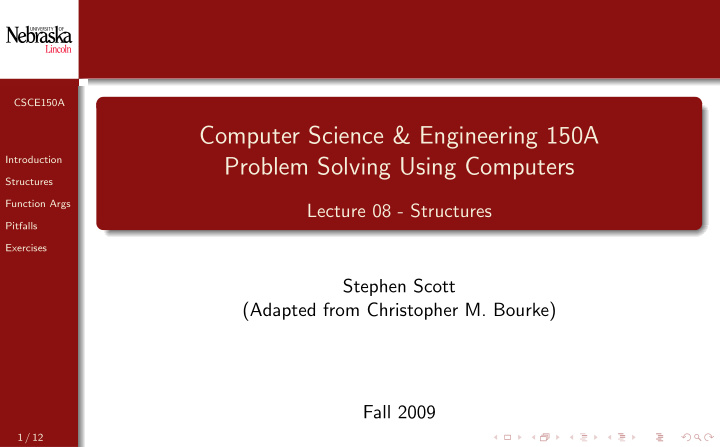



CSCE150A Computer Science & Engineering 150A Introduction Problem Solving Using Computers Structures Function Args Lecture 08 - Structures Pitfalls Exercises Stephen Scott (Adapted from Christopher M. Bourke) Fall 2009 1 / 12
Introduction CSCE150A Introduction Structures Function Args We’ve seen built-in simple data types: int , double , char , etc. Pitfalls Simple data types hold one value at any one time Exercises Complex data types can hold a collection of values 2 / 12
Structures CSCE150A Introduction Structures Function Args C allows user-defined complex types through the use of structures Pitfalls Structures are data types that have components Exercises Components can either be simple data types or other structures 3 / 12
Structure I Syntax CSCE150A Declare a structure using the typedef struct syntax: 1 typedef struct { Introduction 2 int anInt; Structures 3 double aDbl; Function Args 4 Pitfalls int anotherInt; Exercises 5 char aString [20]; 6 } aStructure; aStructure is the name of a new type Can now declare variables of type aStructure just like you’d declare a variable of type int , etc. Each variable of this type has 4 simple data type components 4 / 12
Structures Motivation CSCE150A Introduction Certain data need to be logically grouped together Structures Function Args Records in a database: data associated with a single person should Pitfalls be kept together Exercises A person may consist of first name, last name, NUID, birth date, etc. In turn, a birth date has a month, day, year Structures allow us to define such records 5 / 12
Structures Usage CSCE150A Declare an instance of a structure like you would an atomic type: Introduction aStructure anExampleOfAStructure; Structures aStructure anArrayOfStructures[10]; Function Args Pitfalls To set or access the individual member variables we use the following Exercises syntax: myStructure.memberVariable Known as component selection operator Examples: anExampleOfAStructure.aDbl = 6.5 anArrayOfStructures[3].anotherInt = 4 6 / 12
Structures Example 1 typedef struct { CSCE150A 2 char month [15]; 3 int day; 4 int year; 5 } date_t; 6 Introduction 7 typedef struct { 8 Structures char firstName [30]; 9 char lastName [30]; Function Args 10 int NUID; 11 date_t birthDate ; Pitfalls 12 } student; 13 Exercises 14 int main(int argc , char *argv []) 15 { 16 ... 17 18 student aStudent ; 19 strcpy(aStudent.firstName ,"Tom"); 20 strcpy(aStudent.lastName ,"Waits"); 21 aStudent.NUID = 12345678; 22 strcpy(aStudent.birthDate .month , "December"); 23 aStudent.birthDate .day = 7; 24 aStudent.birthDate .year = 1949; 25 26 ... 27 } 7 / 12
Structures As Function Arguments CSCE150A Introduction It is possible to pass and return structures as function arguments Structures Function Args Same syntax as simple data types Pitfalls You can pass by value or by reference (address, array) Exercises 1 void printStudentRecordByValue (student s); 2 void printStudentRecordByRef (student *s); 8 / 12
Returning Structures CSCE150A Introduction Structures Function Args As with arrays, we cannot return structures that are local in scope Pitfalls We must return a pointer to a dynamically allocated structure Exercises We haven’t covered this in class, but it is in the textbook 9 / 12
Common Errors I CSCE150A Careful: structures must be declared before they are referenced or Introduction used Structures Usually declared between preprocessor directives and function Function Args prototypes Pitfalls The size of a structure is not bounded: you can include as many Exercises components as you want Passing large structures by value is generally inefficient The entire structure is copied to the system stack on a by-value function call Pass large structures by reference (address) whenever possible 10 / 12
Exercise 1 Album Structure CSCE150A Introduction Structures Function Args Design a structure for album data. Include components for album title, Pitfalls artist, track titles, number of tracks, year, and any other relevant data. Exercises 11 / 12
Exercise 2 Complex Numbers CSCE150A A complex number consists of two real numbers: a real component Introduction and an imaginary component Structures Function Args Complex numbers are able to handle roots of negative numbers: Pitfalls Examples: Exercises √ − 4 = 0 + 2 i √ 4 − 4 = 1 + i Define a structure to handle complex numbers. Write a function to print them in a nice format. 12 / 12
Recommend
More recommend